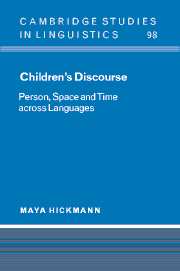Book contents
- Frontmatter
- Contents
- List of figures
- List of tables
- Preface
- List of abbreviations and conventions
- 1 Introduction
- Part I AVAILABLE THEORIES AND DATA
- 2 Theoretical issues
- 3 Cross-linguistic invariants and variations
- 4 Coherence and cohesion in discourse development
- 5 Children's marking of information status: referring expressions and clause structure
- 6 The acquisition of spatial and temporal-aspectual devices
- Part II A CROSS-LINGUISTIC STUDY OF CHILDREN'S NARRATIVES
- Appendix
- Notes
- References
- Author index
- Subject index
3 - Cross-linguistic invariants and variations
from Part I - AVAILABLE THEORIES AND DATA
Published online by Cambridge University Press: 22 September 2009
- Frontmatter
- Contents
- List of figures
- List of tables
- Preface
- List of abbreviations and conventions
- 1 Introduction
- Part I AVAILABLE THEORIES AND DATA
- 2 Theoretical issues
- 3 Cross-linguistic invariants and variations
- 4 Coherence and cohesion in discourse development
- 5 Children's marking of information status: referring expressions and clause structure
- 6 The acquisition of spatial and temporal-aspectual devices
- Part II A CROSS-LINGUISTIC STUDY OF CHILDREN'S NARRATIVES
- Appendix
- Notes
- References
- Author index
- Subject index
Summary
This chapter highlights some universal vs. language-specific properties of linguistic systems which bear on the developmental issues to be raised in subsequent chapters. I first briefly describe some of the general typological dimensions along which languages vary (Section 3.1). I then present in more detail invariant and variable properties of linguistic organisation at the sentence and discourse levels in each of the three domains to be examined subsequently from a developmental point of view. First, denoting entities (Section 3.2) requires the marking of universal distinctions concerning the discourse status of information as a function of mutual knowledge. However, languages rely to different extents on two types of markings: local markings affecting the nominal system and global markings affecting the entire clause. Similarly, space in language (Section 3.3) involves universal distinctions in the representation of motion and location, as well as general principles governing spatial anchoring anchoring in discourse. However, languages vary a great deal in the particular systems of spatial devices they provide and in how they distribute spatially relevant information in the clause. Finally, systems of temporal-aspectual markings (Section 3.4) universally allow speakers to represent various types of situations from different perspectives, to locate these situations temporally, and to ground information as a function of discourse focus. However, they vary in important ways, such as the extent to which markings are grammaticalised, rich, symmetric, and transparent.
- Type
- Chapter
- Information
- Children's DiscoursePerson, Space and Time across Languages, pp. 49 - 85Publisher: Cambridge University PressPrint publication year: 2002



